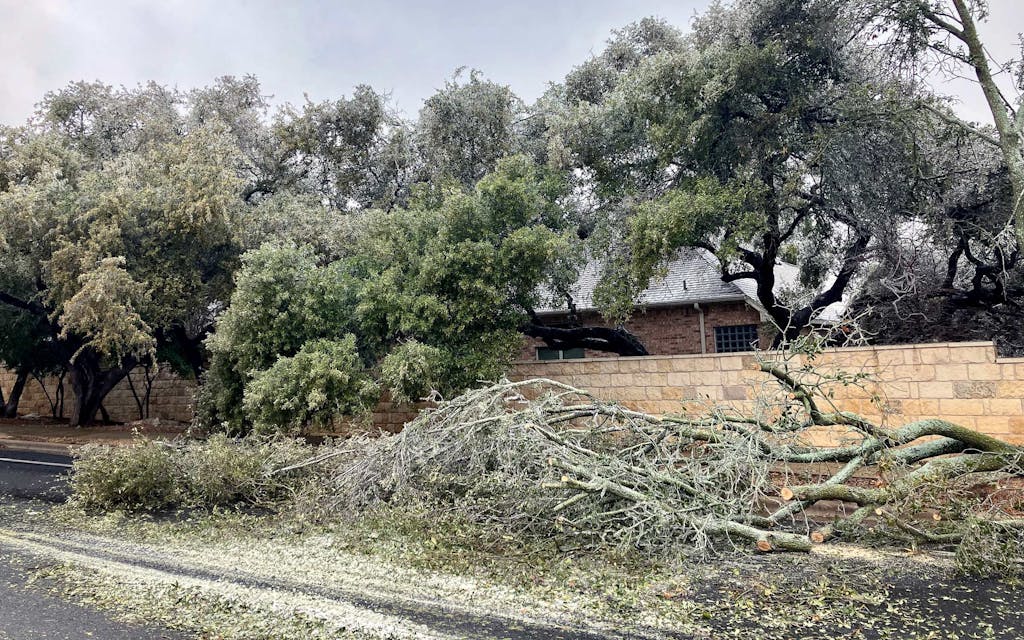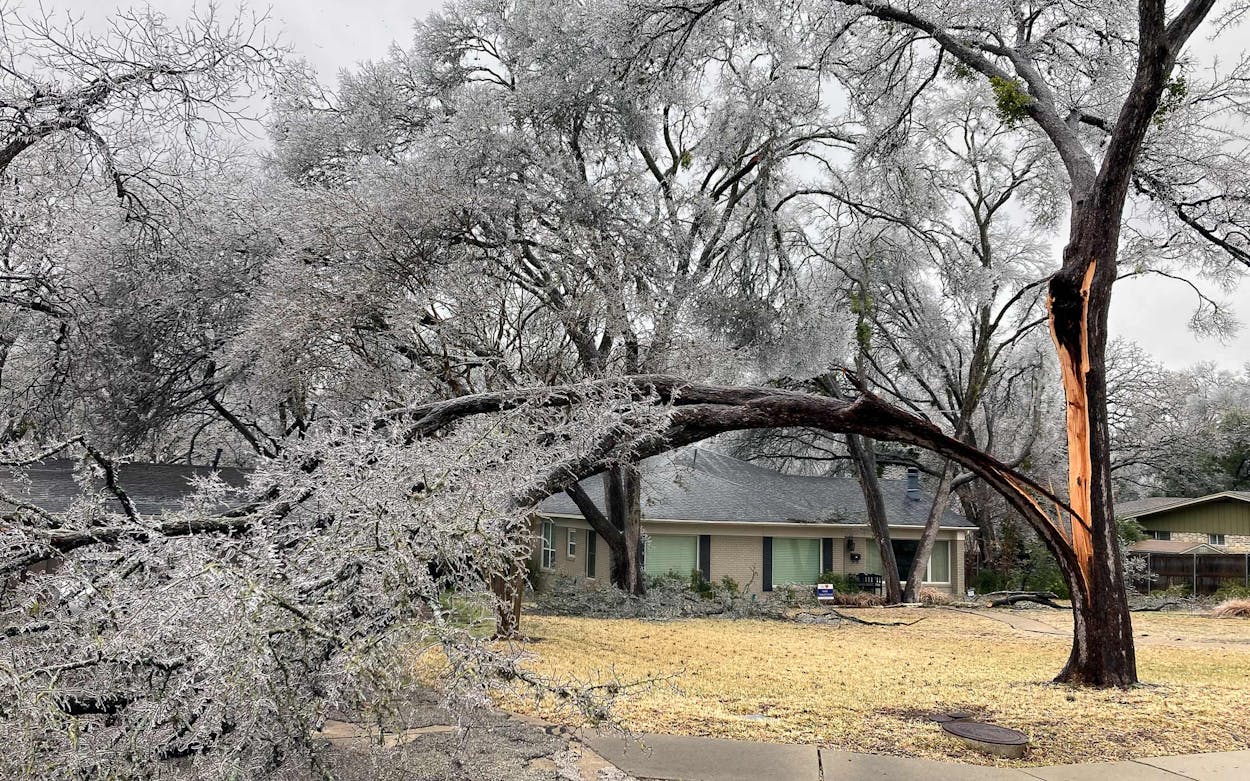Cra-a-ck.
The occasional resounding snap of falling branches (and portions of trees much too big to be called branches) broke up the wintry calm in Central Texas Wednesday. Many woke to an icy wonderland of trees bedazzled and seemingly dripping with the night’s precipitation—a watery, sleety mix sometimes both ambitiously and wrongly called “snow.” Two years out from a harrowing and deadly winter freeze, Texans understandably worried and tweeted and texted about the power grid and the roads and the grocery store lines. They shared funny videos, à la Seattle ice chaos, on TikTok, and they took “Who lost power?” polls in group chats.
But they also talked about the trees. Because, what about the trees?
Roads and yards were littered with fallen limbs, and trees that hadn’t yet lost branches appeared bent and bowed over, weighed down by accumulations of ice. A friend shared a picture of a young tree, the topmost branch of which fully touched the ground, forming a neat arch big enough to walk under.
“It looks painful,” she said. It did, but maybe not as painful as the trees with fresh, light bark exposed at the sites where branches had split and broken away. According to forester Jonathan Motsinger, however, the trees that lost branches were likely feeling pretty good. Lighter, and maybe relieved, if you will.
“Once ice buildup starts getting to the levels that we’re at, with a quarter inch or half an inch, that’s just a lot of weight that’s being put on these trees,” Motsinger, who serves as the Central Texas department head for the Texas A&M Forest Service, says. “The only way for them to relieve the stress and the weight is to break.”
If all of the cracking and snapping is by design, why do fallen trees seem to be an especially big issue right now?
In Austin, the Hill Country, and north San Antonio, fallen tree limbs have been blamed for widespread power outages. Austin’s main power provider, Austin Energy, confirmed that at least 163,000 were without power Wednesday evening, making it the largest outage the utility company has seen since 2021’s freeze, which saw an estimated 220,000 without power. Videos online show heavy, ice-laden tree branches crashing spectacularly into power lines. Some show low-dipping branches resting on sagging lines—one with a small, steady fire burning between the two.
As Motsinger stresses repeatedly, trees are resilient. Most can easily withstand cold temperatures and ice accumulation. Even those bravely attempting a full backbend should be able to right themselves and stand back up once the ice melts. But the fact that the Central Texas region seems to have been especially hard-hit with fallen branches is due in part to the type of tree.
“In a lot of cases it’s not a real big deal. The problem is a lot of the trees we have in this area are live oaks, and live oaks don’t lose their leaves in the fall like most other deciduous trees do,” Motsinger says. “They do a leaf exchange in the spring, but they still have continuous green on the trees throughout the year. What that does is create a lot of additional surface area for ice to build up, which greatly increases the amount of weight that’s on the trees and the strain that they’re under.”
While live oaks are prime candidates for accumulating ice, they’re not the only trees you’re seeing downed. Many Mexican white oaks still have leaves this time of year, and evergreen trees, including ashe junipers—another popular Central Texas variety—are also vulnerable to being overburdened by ice. Additionally, Motsinger says factors like natural branch structure or prior defects in a tree, like dead branches still attached from previous freezes, can lend to the likelihood of felled limbs. Over the past year, Texas has also been suffering from a stubborn statewide drought, the stress of which is thought to “linger for years.”

Watching icy trees struggle, and knowing the weight they’re up against, makes it hard not to wish you could do something to help lighten the load. Motsinger gets it. “There’s a temptation to go out and just try to get the ice off ’em. Chip it off, you know, or shake the tree, or something like that to try to relieve the pressure, but that can be dangerous for several reasons.”
The most obvious being a giant, icy tree branch breaking right over your well-intentioned head. But there’s also a chance that shaking the ice off a tree could permanently damage its cambium, or “living tissue,” and make it more vulnerable to infection in the future. If you absolutely cannot resist doing something for your beloved tree friends, Motsinger has a tip. “With smaller trees, or even potentially bigger trees that have branches that are sagging down, you can put something under those to support that weight,” he offers. “You can gently rest it on a stepladder or something like that just to relieve a little bit of that pressure that’s being placed on the trunk. But for the most part, it’s going to be a wait-and-see sort of situation.”
And, with things set to defrost across the state Thursday, what does Motsinger predict we’ll see after it passes? Aside from overwhelmed tree-care companies and a lot of local cleanup, there are a couple things his team at the Forest Service will be looking out for long term: an increase in contagious oak wilt, with trees made more vulnerable by fresh wounds where branches broke off, and a buildup of branch debris that would heighten the risk for wildfires during fire season in the next few months.
“Trees are very good at the process of compartmentalization, which is where their cellulose structure blocks off areas that have damage or a wound. They start doing this pretty quickly,” he says.
While they work on that, Motsinger urges those of us who live under the branches to focus on staying safe ourselves: Be aware of where you walk and what you’re walking under. Park consciously, avoid disturbing any precarious limbs, and let Motsinger reassure you: “Our tree canopy should remain intact after this. It’ll look a little bit different, but long term . . . these guys are resilient.”
Cra-a-ck.






